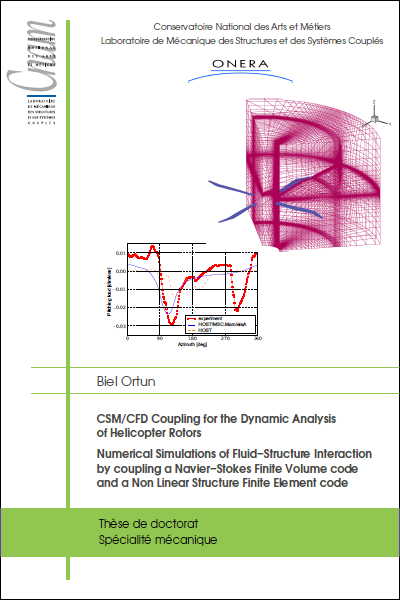PhD Thesis of Biel Ortun
CSM/CFD coupling for the dynamic analysis of helicopter rotors
-
Numerical simulations of fluid-structure interaction by coupling a Navier-Stokes finite volume code and a non linear structure finite element code

Submitted the 18th december 2008 to the jury with members :
| Philippe DEVINANT | Université d'Orléans | Président |
| Marc BERTHILLIER | Université de Franche-Comté | Rapporteur |
| Christophe PIERRE | McGill University, Montreal, Canada | Rapporteur |
| Rogelio FERRER | Eurocopter | Examinateur |
| Jean-Pierre GRISVAL | ONERA Châtillon | Examinateur |
| Didier PETOT | ONERA Châtillon | Co-encadrant de thèse |
| Roger OHAYON | LMSSC, Cnam Paris | Directeur de thèse |
Résumé :
This work has developed a method to perform aeroelastic simulations of helicopter rotors by coupling a three-dimensional finite element structural (CSM) solver to a computational fluid dynamics (CFD) solver and to a flight mechanics code. The objective is to develop a numerical analysis tool able to predict accurately the aeroelastic behaviour of arbitrary rotorcraft configurations and geometries. This is not possible with today’s analyses for rotorcraft aeroelasticity because they are all constrained by the use of beam theory in their structural models.
The basic idea is to use a partitioned approach in which existing specialized software for fluid, structure and flight mechanics are coupled in a time-accurate fashion. The solvers exchange their solutions at each time-step with an iteration-free staggered scheme. For this purpose, a software environment for coupling codes distributed over a network was developed, together with a new method to control the rotor and obtain aeroelastic predictions respecting in-flight equilibrium. The new coupling was applied to the simulation of isolated rotors in level high-speed flight and results were compared to wind tunnel measurements.
The coupling can solve both steady and transient flight conditions, including nonlinear phenomena. It can be used for the analysis of complex, non slender, structures such as bearingless rotor hubs. The partitioned approach enables the exploitation of state-of-the-art methods in each subdiscipline while conserving the energy at the fluid/structure interface, and the iteration-free staggered schemes can yield second-order time-accuracy. The aeroelastic predictions match the flight mechanics targets. The coupling is successfully applied to the aeroelastic simulation of a rotor with 3D finite element modelled blades. Future work will pursue the developments here engaged in view of an industrial deployment.
